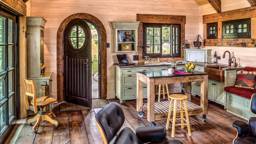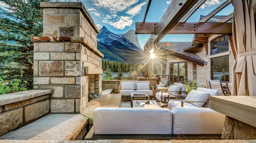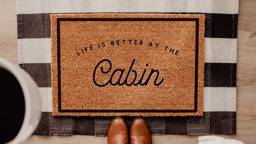
If your cabin’s closets feel overstuffed and undersized, it could be that you’re not using every inch of space you have efficiently. Smart closet design will help you store and organize your clothes and gear. Get inspired with these tips for cabin storage:
Take Inventory
Start your closet overhaul by assessing your space needs, which will vary depending on how often and during what seasons you use your cabin. “For my family, we are constantly lugging clothing from our house in the Twin Cities to our little cabin in Wisconsin, so we mostly live out of our bags on our cabin weekends,” says Sara Pederson, owner of Time to Organize in Shoreview, Minn. “However, there are some items that always stay at the cabin, so maintaining order in the small cabin closets is a must.”
What do you currently store in each bedroom and coat closet? Are there items in those closets that would be best stored elsewhere? Hiking boots or life jackets that might be better located near the door? Puzzles and board games that could find a more convenient home? As you sort through your closets, take the time to jettison things you haven’t used, that no longer fit or that you just don’t like. “If you can’t get this done by yourself, a professional organizer can help,” Pederson says. “The closet design system should come second, after any purging takes place.”

Consider Time-Cost Payoff
Your closet makeover can cost nothing but a few hours of your time or run up to thousands of dollars, depending on your end goal. If you simply need to de-clutter, you can attack the project following a plan you devise yourself or find in any of the myriad sources of information on de-cluttering. If you’d like closets that take advantage of every square inch, a closet system is your best option. Costs for these systems depend on their complexity and who does the design and installation work. A handy DIYer can install a system of wire shelves and basket drawers, but custom systems of drawers, shelves and hanging rods may require professional design and installation.

Plan and Prioritize
If you’re building a new cabin, talk to your designer about including at least the minimum suggested allowances for closets. In general, for a reach-in closet, count on 24 inches in depth from the doorway to the back wall to allow for hanger space. Allowing 5 feet in width for a walk-in closet provides a 3-foot-wide walkway along the hanging space. Seven feet would be needed to have clothes hanging on each side of the walkway.
Some standards for primary homes (not seasonal cabins) suggest estimating 4 feet of hanging space per person who will use a closet. Coat closets should be slightly deeper than a bedroom closet to accommodate bulky coats and jackets on hangers. You can hang a coat about every 4 inches on a rod. A 36-inch wide coat closet is considered a minimum size. In a more casual cabin without a formal entry, the coat closet could be replaced by a mudroom where outerwear, shoes, sporting equipment and more find a place to hang or be stored.
In an already existing cabin, you will want to make the most of the closets you have. First, make sure you’re taking advantage of all your space. Consider literally raising the bar, Pederson suggests. “You can add a second lower rod for double the hanging space,” she says. Double rods are typically placed at 40 and 80 inches above the floor. A single rod for hanging long garments is at 72 inches off the floor.
Especially in a second home, you may have fewer pieces of formal clothing that can’t be folded, so you will need less hanging pole space and more drawers or shelves spaced to accommodate bins or boxes. “Adding a low dresser or cubby system on the floor of the closet can give additional space for folded clothes without taking up floor space in the bedrooms,” Pederson says.
Cubbies can also work for items like shoes or bags. Add hooks to any open wall space in the closet. Over-the-door hanging caddies can easily organize small items like scarves, jewelry, ties or even socks and underwear. Pederson’s go-to organizer is a hanging sweater bag that takes up about 12 inches of rod space but provides a column of shelves that she uses to stash shoes. “It keeps them off the floor and easy to see and grab,” she says. “The bags can also be used to hold rolled-up towels, toiletries and so much more.”
Including extra shelves spaced fairly close together in your closet system allows you to stack just a few items on each shelf, so you won’t have a tumbling tower of clothes every time you pull out a shirt or sweater. If your closet system will have drawers, keep them at eye level or below, so you can see into them when they’re open.
Put things you use most often at eye level. Label bins that are kept up high with their contents, so you know exactly where to look for items. Keeping a small foldable step ladder nearby will help you access items on top shelves. You might need to think outside of the closet box, too. Pederson recommends installing at least one rack of hooks in bedrooms, bathrooms, near the front and back door, and on the porch. “It’s easy to quickly hang clothing – great for sweatshirts, jackets and wet swimsuits – rather than tossing them on the beds,” she explains.
In the coat closet, plan for shoe racks, multiple shelves or rods and back-of-the-door storage to help sort hats, scarves and gloves. The size of your coat closet and when you use your cabin can help determine what should hang out there. If the closet is small and you visit throughout the year, you may need out-of-season coats and gear storage elsewhere.
See also: Clever Bookshelf Ideas

Decide on a Door
Your coat and bedroom closets most likely hide behind a door. If you plan to replace a door or are building a new cabin, you can choose from these options: Conventional interior doors swing open and shut. They are durable and provide a classic look. However, you will need enough clear space around the door to allow it to open fully, a requirement that may eliminate them as a possibility in tight bedrooms.
Sliding doors move along rails on the floor and the top of the closet and require no extra space for clearance. The drawbacks of these doors include only being able to see half of the closet at once and their tendency to derail. Bi-fold doors open more fully than sliding doors but can also come off their tracks on occasion. A small amount of clearance is needed to fully fold the doors open. Pocket doors require no clearance space and allow the closet to fully open. Note: You will need pocket space in an adjoining wall to house the door when it’s open.

All the Bells and Whistles
While closets in luxury homes have morphed into full-blown rooms, you may not have square footage to spare in a cabin. Still, depending on your lifestyle and space, you might want to squeeze in a few of these closet extras:
- Seating in the form of a chair, window seat or bench
- A center island with built-in storage below and a flat top for folding clothes or packing a suitcase
- A fold-down ironing board
- Windows (with some covering for privacy) that can bring in natural light and ventilation.
Sprucing up your cabin closets isn’t a “one and done” task. Pederson suggests a good clearing-out about twice a year. “Near the end of your cabin season, take an hour or two to purge each closet of things that you didn’t use this past season,” she says. “Take them to Goodwill or some other charitable organization, so someone else can enjoy them.”
See also: How to Store Water Gear at the Cabin










